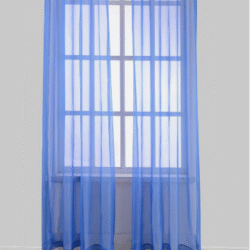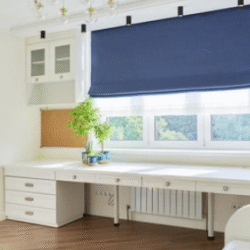curtain hanging loops are a simple yet essential feature that can greatly influence the look and functionality of your window treatments. These loops, whether sewn directly into the curtain or attached as separate rings, determine how curtains are hung, how smoothly they slide, and the overall aesthetic they create. From classic tab tops to modern grommet styles, understanding the different types of curtain loops can help you choose the right option for your space and achieve the perfect balance between style and practicality.
Types of Curtain Hanging Loops
- Tab Top Loops: These loops are sewn into the fabric of the curtain, forming small “tabs” through which the curtain rod passes. They create a casual, relaxed look.
- Eyelet (Grommet) Loops: Large metal or plastic rings sewn into the fabric, allowing the curtain to slide smoothly along the rod. These offer a sleek and modern appearance.
- Pencil Pleat Loops: Typically used with a drawstring or cord, these loops create a pleated look when gathered, offering a more formal, elegant appearance.
- Tie-Top Loops: These loops are simple fabric ties that are tied around the curtain rod. They provide a charming, rustic, or vintage look.
- Rod Pocket Loops: A fabric pocket at the top of the curtain allows the rod to slip through. This is one of the most traditional methods for hanging curtains.
- Hidden Loops: Loops that are sewn inside the curtain fabric, creating a clean and minimalist design where the loops are not visible.
- Double Loops: These loops consist of two sets of loops for a layered, more decorative look, often used in more intricate curtain styles.
How Curtain Loops Affect Curtain Movement
- Smoothness of Movement: Loops like eyelets or grommets allow curtains to slide smoothly along the rod, creating a fluid and effortless movement.
- Easy Opening and Closing: Tab top and tie-top loops can be slightly more resistant to movement, as they often don’t glide as easily as grommet or rod-pocket styles.
- Drape and Flow: The type of loop affects the way curtains hang. For example, pencil pleat loops create more structured folds, while tab tops may give a more relaxed, informal drape.
- Weight Distribution: Heavier curtains benefit from loops like eyelets, which distribute the weight more evenly, allowing them to hang straight and move with less effort.
- Noise Reduction: Grommets and eyelets tend to make less noise when opening and closing compared to some other loop types, which can be more prone to rustling.
- Tension on the Rod: Certain loops, especially tie-top loops, can create more tension on the rod due to the knot or tie, which can affect the ease of movement.
- Adjustability: Tie-top loops and rod pocket loops can offer more flexibility for adjusting the curtain’s position, as they can be tied or adjusted to suit your preferences.
Tab Tops vs. Eyelets: Which is Better?
When deciding between Tab Tops and Eyelets for hanging curtains, it’s important to consider both aesthetic preferences and functionality. Tab tops offer a more relaxed, casual look, making them ideal for rustic, bohemian, or country-style interiors. The loops of fabric that create the tabs are often visible, adding a charming detail that can complement informal spaces. However, tab tops tend to be less practical when it comes to smooth movement. Curtains with tab tops can be harder to slide along the rod, especially with heavier fabrics, making them a less efficient option for frequent use.
On the other hand, Eyelets (or grommets) provide a sleek, modern appearance that fits well in contemporary or minimalist spaces. The large metal rings allow the curtain to glide easily and smoothly along the rod, offering a practical solution for heavier curtains. This style provides a cleaner, more structured look, often appearing more polished and formal. Eyelets also ensure that curtains hang in neat, evenly spaced folds, which can elevate the overall design of a room. However, eyelets require more specific hardware, including a rod designed to accommodate the grommets, which could be more expensive and require extra installation.
Ultimately, the choice between tab tops and eyelets depends on the desired aesthetic and functionality. If you prefer a casual, cozy vibe and don’t mind less smooth movement, tab tops may be the way to go. If you prioritize easy functionality and a modern, clean look, eyelets are likely a better option.
Materials Commonly Used for Loops
- Cotton: A soft, versatile, and affordable material, cotton loops are common for casual or lightweight curtains, offering comfort and breathability.
- Linen: Linen loops provide a natural, textured look that pairs well with both traditional and contemporary interiors, offering durability and a crisp finish.
- Polyester: A popular synthetic option, polyester is durable, wrinkle-resistant, and easy to maintain, making it ideal for everyday use in curtain loops.
- Velvet: Velvet loops add luxury and depth to curtains, often used in more formal or elegant spaces, providing a rich texture and a sophisticated finish.
- Leather: Leather loops create a more rustic, industrial, or modern aesthetic, offering durability and a unique, high-end look, especially in more masculine or contemporary settings.
- Silk: Silk loops are used for premium curtains, offering a luxurious, smooth finish, but require more care and attention due to their delicate nature.
- Canvas: A strong, heavy-duty fabric, canvas loops are suitable for larger or heavier curtains, providing extra support and a sturdy feel.
- Metal: Sometimes used for grommets or eyelet loops, metal provides strength and durability, often seen in modern or industrial designs.
DIY Tips for Adding Curtain Loops
- Measure Carefully: Before adding loops, measure the curtain’s width and height to ensure the loops are spaced evenly and at the correct height for a balanced look.
- Choose the Right Fabric: Select a fabric that matches or complements your curtains. Heavier curtains require sturdier fabrics like linen or canvas, while lighter curtains can use cotton or polyester.
- Use a Strong Needle: When sewing loops, use a strong needle and thread to ensure they hold up over time, especially for heavier fabrics.
- Decide on Loop Style: You can choose between fabric loops (for a soft, natural look) or metal rings (for a more modern, polished appearance). Decide based on your curtain’s style.
- Cut Fabric Strips: For fabric loops, cut strips of fabric to the desired width and length. Ensure the loops are large enough to fit over your curtain rod.
- Sew Loops Securely: Attach the loops securely to the curtain panel using a sewing machine or by hand. Reinforce the edges to prevent fraying.
- Use Curtain Rings: If you prefer a more flexible solution, use curtain rings with clips. Attach them to the top of the curtain, providing an easy way to change the look.
- Consider Fabric Adhesive: For no-sew options, fabric adhesive can be used to attach the loops, though this may not be as durable as sewing.
- Test the Loops: After attaching the loops, test them by sliding the curtain on the rod to ensure they move smoothly and hold the curtain in place
Choosing the Right Loop Style for Your Decor
Choosing the right loop style for your curtains is crucial in ensuring both aesthetic appeal and functionality in your home decor. The style of the loops can dramatically influence the overall look and feel of a room. For a casual or relaxed atmosphere, tab top loops are a great choice, as they offer a soft, informal look that works well in country-style or cozy interiors. On the other hand, if you prefer a modern and sleek appearance, eyelet (grommet) loops are ideal. These metal rings allow curtains to glide smoothly along the rod and provide a clean, contemporary look that complements minimalist or industrial themes.
If you’re aiming for a luxurious and elegant setting, velvet or silk loops will add a rich, sophisticated touch to your curtains, enhancing the elegance of formal living spaces. For heavy curtains or those that need to withstand frequent movement, grommet loops or metal loops provide the durability and support required. If you desire a more minimalist approach, rod pocket loops or hidden loops offer a seamless, understated design that won’t distract from the fabric itself.
Lastly, it’s essential to consider the curtain rod when choosing loop styles. Tab top and rod pocket loops are perfect for standard rods, while eyelet loops may require a more decorative rod to complete the look. Ultimately, selecting the right loop style should balance both your decor’s aesthetic and the practical needs of your curtains.
Loop Placement and Its Impact on Curtain Drape
- Higher Placement for Fuller Drape: Placing loops higher on the curtain panel creates a more dramatic, full drape, as the fabric has more room to fall gracefully.
- Lower Placement for More Structured Look: Loops positioned lower will result in a more tailored, structured appearance, with less fabric pooling at the bottom.
- Even Spacing for Balanced Drape: Ensure loops are evenly spaced along the top edge for a consistent, balanced drape. Uneven placement can lead to irregular folds.
- Loop Size and Drape Effect: Larger loops allow for a looser, more relaxed drape, while smaller loops may create a tighter, more controlled look.
- Impact on Curtain Movement: The position of the loops affects how easily the curtain moves along the rod. Higher or larger loops can make it harder for the curtain to slide smoothly.
- Fabric Type Influence: Heavier fabrics benefit from higher loop placement to allow for a graceful fall, while lighter fabrics may drape more evenly with loops placed lower.
- Custom Drape Styles: Adjusting loop placement can help create customized drape effects, from voluminous folds to sleek, straight lines.
Curtain Loops for Different Rod Types
- Standard Curtain Rods: Tab top and rod pocket loops are ideal for standard curtain rods, as they slide easily without requiring additional hardware.
- Decorative Curtain Rods: Eyelet (grommet) loops work well with decorative rods, adding a modern, stylish look and allowing smooth movement.
- Double Curtain Rods: Tab top or tie-top loops can be used for layering curtains, with the top layer attached to the main rod and the bottom layer to the secondary rod.
- Tension Rods: Rod pocket loops are best for tension rods, as they don’t require additional hardware and fit snugly on the rod.
- Industrial-Style Rods: Metal loops or eyelets complement the industrial aesthetic, providing durability and a sleek appearance.
- Wooden Curtain Rods: Fabric loops (like tab tops) create a softer contrast with wooden rods, offering a more rustic or natural feel.
- Ceiling-Mounted Rods: Eyelet or looped designs can be used with ceiling-mounted rods for a clean, modern, and space-saving curtain hanging solution. Selecting the right loop type based on your curtain rod ensures both functional and aesthetic harmony in your space.
conclusion
In conclusion, curtain hanging loops are a simple yet impactful feature that can significantly enhance the look and functionality of your curtains. Whether you opt for tab top, eyelet, or any other loop style, the right choice will depend on your room’s decor, the type of fabric, and the kind of curtain rod you are using. The placement of the loops also plays a key role in determining the overall drape and movement of the curtains. By carefully considering these factors, you can create a stylish, practical, and tailored window treatment that complements your interior design. Ultimately, curtain loops offer endless possibilities for customization, allowing you to achieve the perfect balance of beauty and function in your living space.




